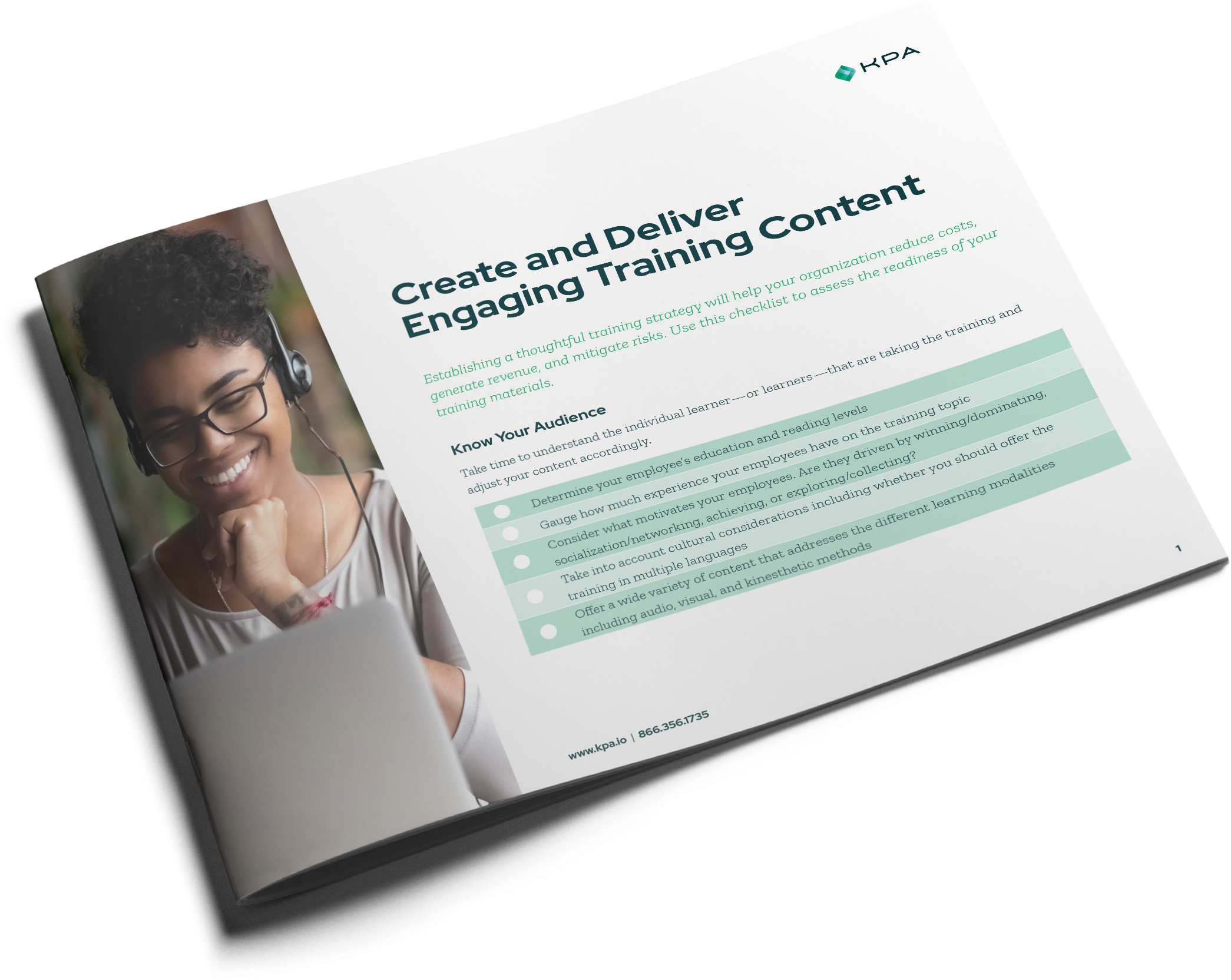At KPA, the training team is excited about the integration of technology in safety training. With younger people entering the workforce and technology advancing rapidly, companies that effectively implement technology in their training have a significant advantage.
From micro-content to gamification, virtual reality, augmented reality, and artificial intelligence, the integration of technology in safety training has the potential to revolutionize the way we train employees. These innovative methods can enhance employee safety, improve retention of information, and attract and retain top talent.
Let’s dive deeper into these technologies and how they can revolutionize safety training to enhance employee safety, improve retention of information, and attract and retain top talent.
Training Technology at our Fingertips: Multimedia and Interactive Content
KPA’s already incorporating some great technologies into our broad library of training titles. We use mobile course training and video-based training, which are great ways of conveying information. Also, multimedia content, interactive content and quizzes, having incident recreations and near misses, including interviews, and are very exciting.
Training Technology at our Fingertips: Gamification
Gamification can help improve safety training by encouraging employees to complete training modules and motivating them with points, badges, and leaderboards. It helps stimulate healthy competition and can make learning more engaging and enjoyable, resulting in better retention of information and increased compliance with safety protocols.
What is Gamification?
Gamification is the process of adding game-like elements to non-game contexts to motivate and engage people.
When it comes to future trends, there are two key areas that the KPA training team is excited about. Let’s examine what’s on the horizon.
Training Technology on the Horizon: Virtual Reality & Augmented Reality
Virtual reality and augmented reality are both newer technologies that are becoming more and more common. You can use these technologies to create immersive training experiences that simulate real-world scenarios. These are interesting concepts that could make safety topics more accessible and effective in helping employees stay safe.
For KPA, specifically in the team that’s working on virtual reality projects, we want to push that experience to make it more immersive. We want people to walk away with an emotional feeling to the experience that becomes more than a talking point. One that contributes to the learning and retention that’s backed by our training.
An example of that would be riding a rollercoaster. We don’t want to read you a step-by-step description, like: “You stand in the line, you get on the rollercoaster, you ride the rollercoaster, and then you get off.” We really want people to leave that training with, yeah, I rode the rollercoaster, and it was “Wow!”
In our recent interview with KPA Training Team member, Mulango Akpo Esambe told us, “That’s a big thing we’re pushing for on VR and AR and mixed reality. I just see the future looking much more like where the technology is more of a companion, much like a hammer or your wrench. As you’re doing work, you’re getting real-time feedback and information on whatever you’re looking at.
If you’re working underneath a car, or you’re replacing a pipe, or you’re operating on heavy machinery, the tech is just another tool in your kit that‘s helping you complete your task safely.”
What is Virtual Reality?
Virtual reality (VR) is a technology that creates a simulated environment that can be experienced through a headset or other devices.
What is Augmented Reality?
Augmented reality (AR) is a technology that overlays digital information onto the real world, enhancing and modifying the user’s perception of reality.

Establishing a thoughtful training strategy will help your organization reduce costs, generate revenue, and mitigate risks. Is your training program up to snuff? Use our training checklist to find out.
Training Technology on the Horizon: Artificial Intelligence and Machine Learning
Artificial intelligence and machine learning can improve safety training in the future by analyzing past incidents, predicting potential hazards, and providing personalized training to employees.
Mulango envisions the future of training including an Augmented Reality avatar who can easily be accessed and give context or solutions in real-time.
One common concern with AI is trusting where a system is pulling its’ information from. As long as that input is coming from a credible source, AI has the potential to be a huge asset for the future of training.
When it comes to machine learning, it’s exciting to imagine training that can be personalized specifically to an individual’s learning style and their progress. Imagine taking a training, and the computer knows “Hey, you learned this way, and based on past tests and past knowledge, we can tailor this training to help you specifically learn what you need to for your own safety.”
What is Artificial Intelligence?
Artificial Intelligence (AI) refers to the ability of machines to perform tasks that typically require human intelligence, such as visual perception, speech recognition, decision-making, and language translation.
What is Machine Learning?
Machine learning (ML) is a subset of AI that involves the use of algorithms and statistical models to enable machines to learn from data and improve their performance on a specific task without being explicitly programmed.
What is an Avatar?
An avatar is a digital representation of a person or character that can be used in virtual environments or online platforms.
The future looks very interesting when it comes to training and technology.
Integrating new technologies like VR, AR, gamification, and machine learning has the potential to revolutionize safety training. These innovative methods can create immersive and personalized training experiences resulting in better retention of information while enhancing employee safety. Companies that adopt these technologies will have a significant edge in attracting and retaining talent, while ensuring that their employees are well-prepared for their roles.
Related Content
Explore more comprehensive articles, specialized guides, and insightful interviews selected, offering fresh insights, data-driven analysis, and expert perspectives.
